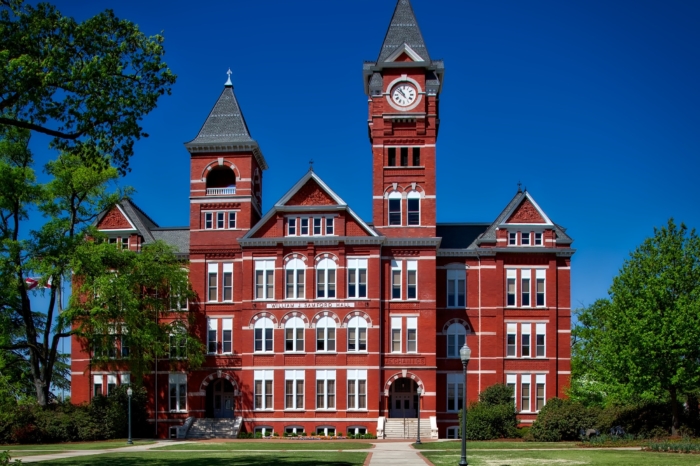Patterns Among Cape Cod Communities with a High Proportion of Private School Students
In Massachusetts, the association between education and demographic factors such as socioeconomic status can be elucidated by examining the New England City and Town Areas (NECTA) data. These data are from Pioneer Institute’s education data on MassAnalysis, part of the Institute’s MassWatch database.
For social, economic, and geographical reasons, certain NECTAs may have higher or lower rates of literacy, education, and public-school students. In the Barnstable, or Cape Cod NECTA, trends among communities with a high proportion of private, homeschooled, or parochial students can be observed.

Table 1
http://massanalysis.com/municipality/
The data reveal that Cape Cod appears to have a significant proportion of students who do not attend public schools, compared to other NECTAs in Massachusetts. The statewide average of private school students in Massachusetts is about 10 percent, according to Pioneer Institute’s databases, thus it seems that one municipality in the Cape Cod NECTA exceeds that statewide average.
Within the Cape Cod NECTA, there is a distinct disparity between municipalities. Notably, Marion has a large number of private, parochial, and homeschooled students. A potential explanation for this is that Tabor Academy, a well-known private school, is located in Marion.
A relationship that is presented in Table 2 is that municipalities with fewer public-school students spend less per capita on public education. A theory behind this relationship may be that Marion and similar municipalities consistently update their expenditures based on the number of public-school students. This notion is developed graphically in Table 2 and figure 3, which present the expenditures per capita and student distribution across types of schools.
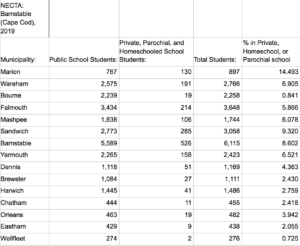
Table 2
http://massanalysis.com/municipality/
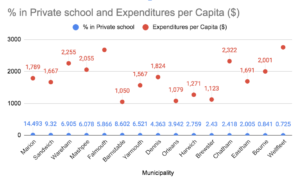
Figure 3
http://massanalysis.com/municipality/
As seen in Sandwich, where 9.3 percent of students are homeschooled or in private or parochial schools, per capita expenditures are $1,667, while Chatham, where 2.418 percent of students are homeschooled or in private or parochial schools, spends $2,322 per capita. This shows that municipalities with a higher percentage of students who are homeschooled or enrolled in private or parochial schools, tend to have lower per capita expenditures than those where a larger portion of students attend public schools. However a possible counter argument is that certain municipalities have more to spend on each student because there are fewer public school students in total.
In addition, it is important to note that wealth of the area tends to be a major moderating variable when considering the relationship between area and the types of schooling that children attend. Compared to the Boston-Cambridge-Newton NECTA, which has a median household income of $95,563, the Barnstable NECTA has a median household income of $82,969 according to the most recent census data. This disparity in overall wealth could explain the trends in the number of students who are homeschooled or attend private or parochial schools.
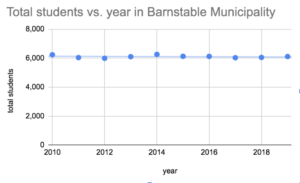

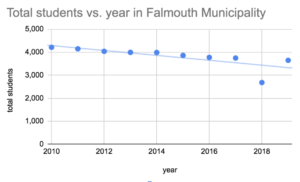

http://massanalysis.com/municipality/
Another trend seen in the data is the reduction in total students in each municipality, and in the Cape Cod NECTA as a whole. For example, the total number of students in Barnstable, Wareham, Falmouth, and Sandwich appears to decline each year. According to the Education Commission of the States, Massachusetts requires kids from the ages 6 to 16 to be in school. Therefore, it is possible that this decline is due to more 17- and 18-year-olds dropping out of school, or to migration out of Massachusetts. However, according to this article by CommonWealth magazine, the majority of the decline in public school students stems from families choosing to homeschool their children when they are in kindergarten rather than sending them to a public school.
This general reduction in the number of students is concerning. Especially since, as more data become available, we’re likely to see that the COVID-19 pandemic had a devastating effect on school enrollment and attendance in Massachusetts.
Nathan Bornstein is a Roger Perry Intern at Pioneer Institute. He is a rising senior high school student at the Buckingham Browne & Nichols school in Cambridge, Massachusetts. His favorite subjects at school are history, math, and foreign language.

